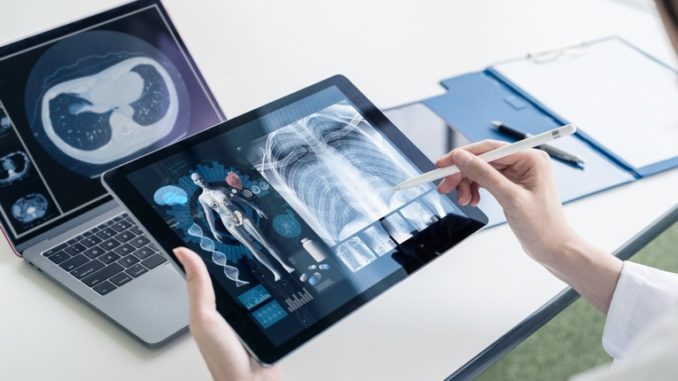
ID Medical have analysed data from the NHS Long Term Plan to reveal what the future of healthcare will look like
Almost every aspect of modern life has been radically reshaped by technology, and healthcare is no exception. Technology is continually opening up new possibilities for prevention, care and treatment, but how will technology transform the future of healthcare?
Digital apps will be used to support medical care and treatment
By 2020 a number of technologies that deliver digitally-enabled models of therapy for depression and anxiety disorders will be used in Improving Access to Psychological Therapies (IAPT) services across the NHS. This will later expand to include other modes of delivery, such as virtual and augmented reality.
In 2020/21 people will have access to their care plans and communications from their care professionals via the NHS app, which will enable people to manage their own health needs or direct them to the appropriate service. If needed, they will be connected with their local services to get an appointment with an urgent treatment centre, or be prescribed medicine to be collected from their nearest pharmacies.
The whole country will be able to access their maternity records digitally by 2024. Additionally, a digital version of the ‘red book’ will help parents record and use information about their child, including immunisation records and growth. This will help children start life with a digital personal health record (PHR) that they can build on throughout their lives.
Technology will enhance specialist medical care
By 2022 technology will give clinicians easy access to referral templates and ‘one click away’ specialist advice and guidance for GPs, which will avoid many patients requiring referral for an appointment. Triaging some specialist referrals, using photos and questionnaires, will allow some patients to have entirely virtual assessments.
Diagnostic imaging networks will enable the rapid transfer of clinical images from care settings close to the patient to the relevant specialist clinician by 2023. This will help improve timely image reporting, as well as the development of large clinical data banks to fuel research and innovation.
Healthcare and nutrition plans will be personalised for the individual
By 2025 data will be collected by your wearable or implantable health monitoring devices and, by analysing your gut bacteria, future dieticians will be able to tailor a diet plan to better fit your unique DNA and metabolism. We will also, one day, apply this approach to a genome-customised exercise routine.
Blood samples will be taken at birth and analysed to identify the health issues your DNA makes you predisposed to. A personalised ‘healthcare roadmap’ will be created detailing the custom vaccines, gene therapies and surgeries you will need over the next 20-50 years, to avoid serious health complications.
In 2030 this information will be collected using intuitive tools, that will be deployed to capture data which empowers clinicians and reduces the administrative burden. Clinical, genomic and other data will be linked, to support the development of new treatments. Data will be made secure through the implementation of security, monitoring systems and staff education.
Digital-first approaches will be used to diagnose and treat patients
By 2030 artificial intelligence (AI) will be used to help clinicians in applying best practice and supporting patients in managing their health and condition. Predictive techniques will be used to support local health systems to plan care for populations. When ill, people will increasingly be cared for in their own home, with the option of having their physiology effortlessly monitored by wearable devices. People will be helped to stay well, to recognise important symptoms early, and to manage their own health, guided by digital tools.
In ten years’ time the NHS will offer a ‘digital first’ option for most people, allowing for longer and richer face-to-face consultations with clinicians where patients want or need it. By 2035 you will have access to virtual consultations with a doctor via video call or webchat. If bio-samples are needed, and you are not able to visit a clinic in person, a medical drone will be flown in to deliver and return a medical testing kit.
AI supercomputers will analyse your bio-samples, such as like saliva and blood, and be able to diagnose your condition within minutes, rather than weeks, and with a 90% accuracy rate.
Futuristic technology will be used to pre-empt illness and treat in medical emergencies
Implants injected under the skin will analyse your blood for toxins, viruses, and bacteria by 2035. Data collected by these implants will be shared with your personal health app, online health monitoring subscription service, or local healthcare network, to warn you of an impending illness before you even feel any symptoms.
Only five years after this, in 2040, drones will be sent out ahead of ambulances to provide early care while paramedics are en route. By the early 2040s most ambulances will be quadcopters that can land anywhere and be flown by GPS or a pilot. These quadcopters will offer faster response times by avoiding traffic and being able to reach even the most remote destinations.
Human medical professionals will remain key in delivering care
With technology quickly advancing every day it is very likely that the future of healthcare will be largely reliant on digital automation and robotics. Medical professionals, in the future, will have to learn a range of new skills, including how to operate this new technology, and how to effectively deliver virtual appointments, diagnosis and treatment procedures. Medical professionals will also have to learn how to interpret data from patients’ wearable devices, digital records and genome and DNA data to make diagnoses, supported by AI technologies to increase efficiency.
However, while technology will feature heavily in the healthcare of the future, medical professionals will remain key in delivering care, and will play a major role in treating patients who cannot or do not want access to the technology in place.
Click here to view the ID Medical future healthcare and technology infographic.
Don’t forget to follow us on Twitter, or connect with us on LinkedIn!


Be the first to comment